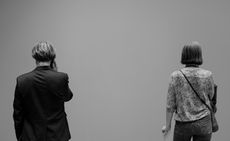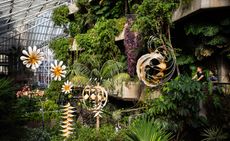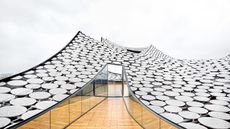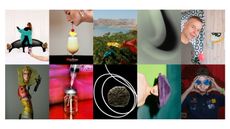Constructing Worlds: a new exhibition at the Barbican gives architectural photography the exposure it deserves

Considering that the world’s very first photograph – or rather, the earliest known photograph made with a camera, the View from the Window at Le Gras by French scientist and inventor Joseph Nicéphore Niéce – was famously an architectural one (taken in 1826 or 1827), it’s surprising that this is the first major London exhibition to focus specifically on the extraordinary, ongoing relationship between photography and architecture. ‘Constructing Worlds: Photography and Architecture in the Modern Age’ opened this week at the Barbican Art Gallery in London, as an ode to architectural photography and its power to change the way we see buildings, urban environments, and even, consequently, the world.
It’s a relationship born, though, of more pragmatic impulses. ‘At first it was for purely practical reasons,’ says the Barbican Art Gallery’s associate curator Alona Pardo. ‘Buildings provided a static object necessary for long exposures. Photographers then sought to record and interpret architecture.’ Architects themselves have also understood the power of the right photographic image to communicate their ideas and concepts, with the International Style being a prime example of an architectural movement that travelled the world via the lens of a camera. Good photography can vastly influence a building’s public standing.
Co-curated by Pardo and author and curator Elias Redstone, ‘Constructing Worlds’ was born out of the latter’s research for his book, Shooting Space: Architecture in Contemporary Photography. The exhibition touches on the work of a carefully chosen group of 18 leading photographers and artists, whose work examines architecture in different ways and across the globe. Having looked through countless images, the team is presenting 250 works that show the photographers’ aesthetically striking and visually distinct portrayals of architecture, and also hint at its symbolic qualities.
‘The artists and works in the show tell a global story and look at the world with a modern gaze,' says Redstone. ‘The exhibition presents a broad spectrum of photographic approaches. We’ve also brought together our own curatorial interests.' The architectural subjects are equally diverse, ranging from Le Corbusier and Frank Lloyd Wright classics to humble vernacular buildings. Still, themes do emerge. Urban and suburban landscapes, the city and street life, the iconic and the mundane, military architecture and the architecture of authority, mass urbanisation and globalisation all figure as topics in the show. Similarly, the impact of the car is addressed in several artists' works, such as Ed Ruscha’s Thirtyfour Parking Lots in Los Angeles.
Redstone explains that the exhibition – designed by Brussels architect from Office KGDVS, with graphics by Atelier Dyakova and Stef Orazi, the latter also designing an accompanying book – has three distinct chapters: the fascination with vernacular architecture in the 1960s and 1970s; responses to and collaborations with individual architects and buildings; and photographers’ takes on globalisation and urban growth in China, Africa, Latin America and the Middle East. The works are shown in chronological order, starting with Berenice Abbott’s seminal Changing New York project, Walker Evans’ documentation of local building typologies in the deep south, Julius Shulman’s iconic images of the Case Study Houses and Lucien Hervé’s images of Le Corbusier’s Chandigarh.
This exhibition aims to inspire, inform but also to pose questions. ‘Why do streets look and feel the way they do?’ asks Pardo. 'What does a soaring skyscraper reveal about our society?’ So many of our encounters with great architecture happen through the printed pages of a book, magazine or the vast visual resources of the digital world, and the command photography has in shaping our perception of the built world is undeniable. A visit to ‘Constructing Worlds’ will help explore this fascinating bond.

Co-curated by the Barbican Art Gallery’s associate curator Alona Pardo and author and curator Elias Redstone, the vast exhibition touches on the work of a carefully chosen group of 18 leading photographers and artists, whose work examines architecture in different ways and across the globe.

The works are shown in chronological order, starting with Berenice Abbott’s seminal Changing New York project (pictured)

The architectural subjects are diverse, ranging from Le Corbusier and Frank Lloyd Wright classics to humble vernacular buildings. Pictured is 'High Court of Justice, Chandigarh', by Lucien Hervé, 1955. Los Angeles. With permission from Fondation Le Corbusier, Paris and Judith Elkan Hervé. 2014 DACS and J Paul Getty Trust

'Jewish Museum Berlin, Daniel Libeskind, Untitled 9', by Hélène Binet, 1997.

The exhibition includes 250 works that show the photographers’ aesthetically striking and visually distinct portrayals of architecture, and also hint at its symbolic qualities.

'Torre David #2', by Iwan Baan, 2011. Los Angeles

'Dodgers Stadium, 1000 Elysian Park Ave.', by Ed Ruscha, 1967/1999. The impact of the car is addressed in several artists’ works, such as Ed Ruscha’s Thirtyfour Parking Lots in Los Angeles. Ed Ruscha.

Urban and suburban landscapes, the city and street life, the iconic and the mundane, military architecture and the architecture of authority, mass urbanisation and globalisation all figure as topics in the show.

'Cooling Plant, Dubai', by Bas Princen, 2009.

'Chongqing IV (Sunday Picnic), Chongqing Municipality', by Nadav Kander, 2006.

'World Trade Centre (Minoru Yamasaki)', by Hiroshi Sugimoto, 1997.

The artists and works in the show tell a global story and look at the world with a modern gaze,' says co-curator Elias Redstone. ‘The exhibition presents a broad spectrum of photographic approaches.

Redstone explains that the show – designed by Brussels architect from Office KGDVS, with graphics by Atelier Dyakova and Stef Orazi – has three distinct chapters.

'A security guard's booth at the newly restored Ikhtiaruddin citadel, Herat', by Simon Norfolk, 2010-2011.

'Case Study House #22', by Julius Shulman, 1960. J Paul Getty Trust. Research Library at the Getty Research Institute

This is the first major London exhibition to focus specifically on the extraordinary, ongoing relationship between photography and architecture.
ADDRESS
Barbican Centre
Art Gallery, Level 3
Silk Street
London EC2
Wallpaper* Newsletter
Receive our daily digest of inspiration, escapism and design stories from around the world direct to your inbox.
Ellie Stathaki is the Architecture & Environment Director at Wallpaper*. She trained as an architect at the Aristotle University of Thessaloniki in Greece and studied architectural history at the Bartlett in London. Now an established journalist, she has been a member of the Wallpaper* team since 2006, visiting buildings across the globe and interviewing leading architects such as Tadao Ando and Rem Koolhaas. Ellie has also taken part in judging panels, moderated events, curated shows and contributed in books, such as The Contemporary House (Thames & Hudson, 2018), Glenn Sestig Architecture Diary (2020) and House London (2022).
-
 Ruark Audio and Revo give the CD player revival a fresh spin
Ruark Audio and Revo give the CD player revival a fresh spinRuark Audio’s new R-CD100 and the Revo SuperCD are joined by two more quirky devices to revive those classic discs
By Jonathan Bell Published
-
 The new Ford Capri wants to tap a vein of Gen X nostalgia. Does it succeed?
The new Ford Capri wants to tap a vein of Gen X nostalgia. Does it succeed?We ask if the all-electric Ford Capri can capture the swagger of its much-loved but rather oafish predecessor
By Guy Bird Published
-
 Rug designer Sibylle de Tavernost’s homage to Fernand Léger
Rug designer Sibylle de Tavernost’s homage to Fernand LégerAbstract modern art, craft heritage and contemporary life fuse in Sibylle de Tavernost's new limited-edition rugs
By Harriet Thorpe Published
-
 Looking at people looking at art: inside the mind of a gallery attendant
Looking at people looking at art: inside the mind of a gallery attendantVisitor experience workers at London’s Tate Modern, Serpentine, Barbican and V&A share what it’s like to watch people looking at art during a time of changing attention spans and rising vandalism
By Kyle MacNeill Published
-
 London art exhibitions to see in November
London art exhibitions to see in NovemberRead our pick of the best London art exhibitions to see this month, from Frances Bacon at The National Portrait Gallery to Genesis Belanger at Pace gallery
By Tianna Williams Last updated
-
 Ibrahim Mahama tells us why he has covered the Barbican in pink fabric
Ibrahim Mahama tells us why he has covered the Barbican in pink fabricIbrahim Mahama's 'Purple Hibiscus' has transformed the Barbican’s Lakeside Terrace
By Hannah Silver Published
-
 Politics, protest and potential: the Barbican explores the power of textiles in art
Politics, protest and potential: the Barbican explores the power of textiles in artUnravel: The Power and Politics of Textiles in Art’ at the Barbican Centre in London explores how far the medium has evolved in the last sixty years
By Emily Steer Published
-
 Ranjani Shettar’s site-specific sculptures unveiled in Barbican Conservatory
Ranjani Shettar’s site-specific sculptures unveiled in Barbican ConservatoryRanjani Shettar’s ‘Cloud songs on the horizon’ suspends sculptures amid the Barbican Conservatory’s plant life
By Francesca Perry Published
-
 Inside Ricardo Bofill’s Walden 7, a cathedral of postmodern curiosity
Inside Ricardo Bofill’s Walden 7, a cathedral of postmodern curiosityA new series by architectural photographer Sebastian Weiss takes us on a tour of Walden 7, Ricardo Bofill’s majestic Catelonian apartment building – a cathedral of utopian curiosity and community
By Harriet Lloyd-Smith Published
-
 Heaven on Earth: architect Toshiko Mori curates Candida Höfer’s sublime new photography show
Heaven on Earth: architect Toshiko Mori curates Candida Höfer’s sublime new photography showAt Sean Kelly, New York, architect Toshiko Mori is curating a new show by Candida Höfer, spanning a 30-year period of the German photographer’s spatially sublime work
By Pei-Ru Keh Published
-
 10 Wallpaper* photography moments of 2022, from piña coladas to Pipilotti Rist
10 Wallpaper* photography moments of 2022, from piña coladas to Pipilotti RistThe most memorable Wallpaper* photography moments of 2022, courtesy of our esteemed photo desk
By Holly Hay Published